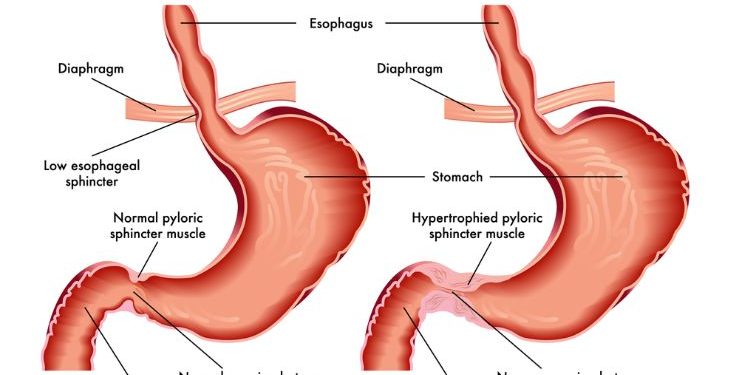Pyloric Stenosis symptoms include a baby’s difficulty with keeping food down after a feeding and vomiting frequently or sometimes forcefully. This is usually a sign of pyloric stenosis and often happens in babies younger than 6 months of age.
Spitting up is common for newborns and most babies spit up after every feeding but it may become more frequent over time or turn into projectile vomiting (forceful, non-bilious vomiting). It’s important to see your doctor if this spitting up becomes more frequent or is projectile vomiting as it can be a sign of pyloric disease.
Frequent vomiting: The first sign that your baby might have pyloric stenosis is that they are having a hard time keeping food down after each feeding. This happens because breast milk or formula can’t pass easily through the pylorus, which is the muscle that allows food and liquids to enter the small intestine. The pylorus becomes thick and long, which makes it difficult for foods to go into the intestines.
Vomiting: As the pylorus gets thicker, the baby’s stomach contents will not have enough room to pass through it. During the vomiting, waves of contractions ripple across the top of the stomach from left to right as the pylorus tries to push the food through it. The stomach may also feel “tight.”
Changes in stools: Babies with pyloric stenosis have less bowel movement, smaller bowel movements or no bowel movement at all because little or no food is reaching the intestines. They will have fewer wet nappies or diapers that are not as wet as you think they should be.

Dehydration: The severe vomiting can cause a baby to become very dehydrated and deplete their fluids and electrolytes. This can lead to a dangerously low sodium level in the blood. They will need frequent blood tests to make sure they’re getting enough fluids and salts.
Weight problems: The pylorus is not wide enough to allow foods to pass into the small intestine, so babies with this condition aren’t able to get adequate nutrients to grow properly. This can result in poor feeding, weight loss, and trouble gaining weight as the child grows older.
Surgical repair: If your baby has pyloric stenosis, they might need surgery to correct the problem. It’s a safe and effective procedure that can improve the symptoms of pyloric stenosis. It’s most likely to be done as an outpatient, although there are times when a hospital stay is needed.
The operation will involve making a small incision in the stomach and enlarging the pylorus so that the food can pass more easily. It is usually performed using a laparoscope, which is a tube with a camera attached. Your child will have general anesthesia to sleep during the surgery.
Surgery for pyloric stenosis rarely happens in adults but it can happen when the problem is caused by an attributable cause such as an adjacent ulcer, infection, abnormal anatomy or allergy, or a rare metabolic disorder (such as galactosemia). In most cases, these conditions are diagnosed and treated before the pyloric stenosis worsens and causes gastrointestinal form and function to be affected.









